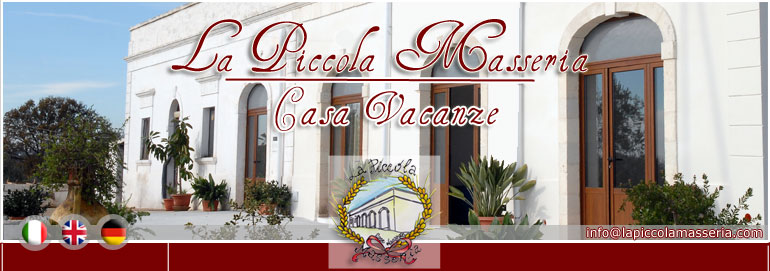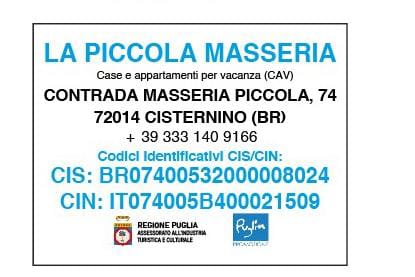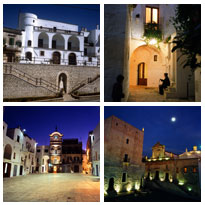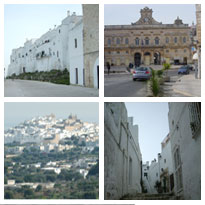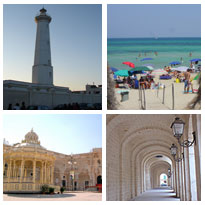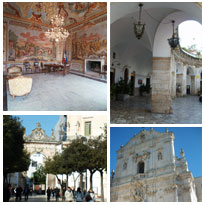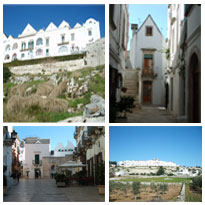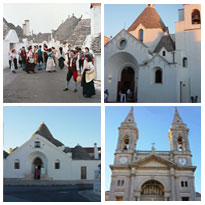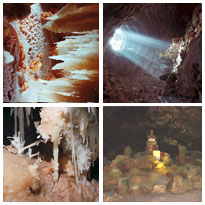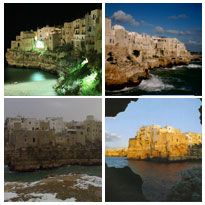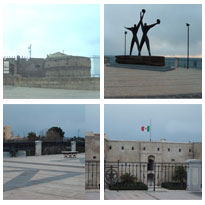CISTERNINO
It is located on a hill in the heart of Apulia, in the province of Brindisi, at 394 m above the sea level; it faces at south-west on the splendid Itria-valley and at north-east on Adriatic coast which is about 12 km away. Although, it is a small town of about 12,000 inhabitants, which extends over 54 square km, Cisternino is an emerging tourist centre and more and more destination of the lovers of folclori and of relaxed and healthy live. Here, tourists can visit the splendid Cathedral “San Nicola” with the famous sculpture “La Madonna del Cardellino”, the main square Vittorio Emanuele with the clock tower, living heart of summer evenings, the suggestive old town, the Belvedere on the Itria-valley, the Sanctuary of Madonna d'ibernia and l'ashram of the Community of Bhole Baba, religion of Indian origin that has found in this land the source of spiritual well-being. For whom loves the good cuisine, it is possible to taste the various local culinary delights such as, “bombette” (tipical grilled beaf meat) , “orecchiette con le cime di rape” (tipical pasta of this area with turnip) , “taralli”, “focaccia” and so on. www.comune.cisternino.brindisi.it
|
|
IN THE SURROUNDING AREA WE SUGGEST (within 30 minutes by car):
OSTUNI
It rises with its white splendor on three hills, at the ends of the Murge-chain at 299 mt. above sea level. Its territory extends for approximately 206 sq km. from the last offshoots of the Murge to Adriatic Sea. The inhabitants of Ostuni are approximately 33,000, which triple in the summer because it is an important tourist centre known throughout the world. The houses covered with lime and the peculiar topography have merit fabulous names, such as white town “Citta Bianca”, Queen of olive-trees “Regina degli ULIVI”, City crib “Città presepe”. Its old town is a fascinating tangle of narrow and winding streets and squares that meet to five doors, which during the night many decades ago were closed to protect the citizens. www.comune.ostuni.br.it
|
|
FASANO
It is a tourist town with a wide agricultural and craft tradition. The present city of Fasano takes its roots from Casale di S. Maria de fajano, built in 1088 by the people who had abandoned the ruins of Egnatia. Last of the “Messapica” cities, at the borders with “Japiga”, Egnatia became in the Roman period one of the major steps of the roman street “Appia-Traiana” that ended in Brindisi. Here, tourists can visit its archaeological park and its museum. Moreover, between the leisure activities that this city offers, should be mentioned the spas of Torre Canne, one of the complex, best equipped in Europe, the Fasanolandia and the Zoosafari that, with its 140 hectares, is the largest Zoosafari in Europe and the golf course San Domenico that rises on the border between the ancient city of Egnatia and the harbour of Savelletri. www.comune.fasano.br.it
|
|
MARTINA FRANCA
It is an elegant town situated at 431 m. above the sea level, situated on one of the last hills in the south of Murgia chain and also it dominates the enchanting Itria Valley, splendid and green valley with Trulli (typical construction of this area made by limestones). The main attraction of the city is, without any doubt, the typical old town, a splendid example of baroque art, with its narrow streets, its white alleys, the noble palaces and the majestic and monumental churches. The area is characterised by a colourful landscape dotted by the ancient “CASEDDE”, the famous Trulli and the typical buildings of the farms. www.comune.martina-franca.ta.it
|
|
LOCOROTONDO
Also known by the peasants as 'U curdùnne' . This pretty village overlooks on the Itria Valley and it rises on one of the last hills of Murgia-hill chain. Locorotondo owes its name to the shape of the first inhabited centre, built around 1000 century. This first village was composed of farmers’ houses built one leant against other following a circular map. It’s possible to visit the following sites: the medieval village, the church of Madonna of Greek and the Cathedral Church dedicated to San Giorgio. Finally, tourists can’t miss the visit of the wine-cellar where the famous white wine named “Locorotondo Doc” is produced. www.comune.locorotondo.ba.it
|
|
ALBEROBELLO
It stands on two hills that anciently were devided by a mainstream. There is the new town with modern architectural features is on the east hill, and at the top of a west hill the area of 'Trulli', that is divided into two main districts: Monti and Aia Piccola World Heritage recognised by UNESCO. Trullos are built of limestone, the 'chiancole', which covers the cone and creates the wonderful city, the most unique in the world, that today everybody can admire. Since the birth of Alberobello, the material for the construction and the covering of Trulli was obtained from calcareous rocks. The history of this singular town dates back to the second half of the XVI century, when the farmers began to settle in the “Selva” area it became very fertile. The feudal owners of the place permitted the settlers to build trulli, because they could be easily demolished by removing the key stone in case of unexpected royal inspection. That was because the ruler demanded tax payment imposed on the town houses and with this cunning proposal they evaded this property tax. In 1797, thanks to the intervention and the assistance of King Ferdinand IV of Bourbon, the small village of Alberobello became free. www.comune.alberobello.ba.it
|
|
CASTELLANA GROTTE
The heart of the land of secular olive groves and the blue Adriatic-sea preserves a treasure, the marvellous Castellana grottoes. Castellana is called 'Castellana Grotte' from 1950 in tribute to a marvellous underground world discovered by Prof. Franco Anelli in 1938. Instead, as regards the town Castellana, the first documentary-traces dates back to 901 but it is likely that it was a simple rural area. A certain concentration of houses and a stable population of farmers starts only from the end of the 1100 as the official documents of counts of Conversano declare. www.comune.castellanagrotte.ba.it
|
|
POLIGNANO A MARE
Overlooking the Adriatic Sea, on a surface of approximately 63 square kilometres and with a triangular geometric form, rises a small town, called Polignano a Mare remembered by many travellers as 'the pearl of Adriatic sea'. From ancient origins, the old Neapolis is 30 km far from Bari, at the South-East side. Its proximity to Bari, has meant that this small town centre, composed of about 17,000 inhabitants, can have a strategic geographical position, so that it could be considered, in fact, a window on the whole Mediterranean sea. It can be considered a meeting point between the sea and earth, the city of Polignano a Mare, in fact, has always been the crossroads of wayfarers from various cultures, during all centuries: Arabs, Byzantines, Spanish and the Normans that have left permanent traces of own presences. Moreover, this city gave birth to a famous Italian singer as 'Domenico Modugno' that with the song 'Volare' has enchanted the whole world. www.comune.polignano-a-mare.ba.it
|
|
TARANTO
The light, the colors, the climate, the kindness of the people, the history, the culture, the geographical position, the sea: all these elements and more contribute to make Taranto exeptional and full of charm. It is located between “Mar Grande” and “Mar Piccolo” and for this reason has the epithet 'city of the two seas'. The city is divided into the new city and the old town by an artificial channel and connected by the famous revolving bridge “Ponte Girevole”. The new city developes rapidly, and is now the Taranto’s most representative area. Sites that must be visited are the millenary cathedral of S. Cataldo, with its primitive Romanesque style, the high double scale baroque and the grandiose ogival portal of S. Domenico, the impressive “Aragonese castle” that overlooks the channel, which are still the symbols of the city. www.comune.taranto.it
|
|
At about 1 hour, you can visit Matera with its famous "Sassi" that is a part of UNESCO heritage, Castel del Monte famous Residence of Emperor Federico II, Otranto with its Cathedral and its mosaic floors and Lecce Capital of the baroque famous in all the world, finally Bari with the Basilica “Pontificia San Nicola” and Trani with its splendid Romanesque cathedral.
|
